Services on Demand
Journal
Article
Indicators
-
 Cited by SciELO
Cited by SciELO -
 Access statistics
Access statistics
Related links
-
 Cited by Google
Cited by Google -
 Similars in
SciELO
Similars in
SciELO -
 Similars in Google
Similars in Google
Share
Papel Politico
Print version ISSN 0122-4409
Pap.polit. vol.14 no.1 Bogotá Jan./June 2009
Recibido: 20/03/09
Aprobado evaluador interno: 12/04/09
Aprobado evaluador externo: 16/04/09
**Ph.D candidate in Political Science at York University; master of Political Science from Laval University; interests include international political economy, critical security studies, and peasant studies. E-mail: dtoconno@yorku.ca.
Resumen
Este estudio proporciona estimaciones científicas de los ingresos anuales generados por la industria ilícita de la cocaína en Colombia (1991- 2007), a partir de los datos sobre la producción de coca recogidos por la Oficina de las Naciones Unidas contra la Droga y el Delito. Mientras los productores colombianos reciben solo una fracción de los ingresos globales de tráfico de cocaína y de las ventas, el control de la producción y la apropiación de los ingresos están altamente concentrados, lo que señala la gran capacidad de las empresas de drogas ilícitas para afectar a la economía y sociedad colombiana. Comparamos narco-acumulación de capital en el contexto más amplio de la economía colombiana en términos de productividad, pautas de empleo, crecimiento, concentración de la riqueza y poder. Así, la producción de estupefacientes es uno de los más productivos y lucrativos sectores de la economía. Si bien el potencial de ganancias es alto, la naturaleza ilegal de la industria —las empresas son propensas a la violencia y el sabotaje de los competidores y vulnerables a los intentos de represión de la producción por el Estado— hace que esta sea muy volátil y arriesgada. El dinero ilegalmente acumulado de las drogas puede servir como una fuente de financiación para las actividades económicas legales; lo que se hace evidente en el crecimiento económico en el sector formal, así mismo, hay que decir que este se utiliza también para financiar los grupos armados ilegales que contribuyen a la violencia y la inseguridad, en particular en contra de los campesinos rurales.
Palabras clave autor
Colombia, tráfico ilícito de drogas, producción de cocaína, narcotráfico, narco-capital.
Palabras clave o descriptores
Narcotráfico - Aspectos socioeconómicos - Colombia, Industria de la coca, Colombia - Política económica
Abstract
This study provides up-to-date scientific estimates of annual revenues generated by Colombia's illicit cocaine industry (1991-2007), imputed from data on coca production collected by the United Nations Office on Drugs and Crime. While Colombian producers appropriate only a fraction of global revenues from cocaine trafficking and sales, control over production and appropriation of revenues is highly concentrated, suggesting a great capacity for illegal drug-firms to impact Colombian economy and society. We compare narco-capital accumulation within the wider context of the Colombian economy in terms of productivity, employment patterns, growth and concentration of wealth and power and find that narco-production ranks among the most productive and lucrative sectors of the economy. But while the potential for profits is high, the illegal nature of the industry means firms are prone to sabotage and violence from competitors and vulnerable to attempts at suppression of production by the state, making the industry highly volatile and risky. If illegally accumulated drug-money can serve as a source of financing for legal economic activities, thus propping up economic growth in the formal sector, it must also be said that illegally accumulated narco-dollars are used to finance illegal armed groups and contribute to violence and insecurity, particularly for rural peasants.
Key words author
Colombia, illicit drugs, cocaine production, drug trafficking, narco-capital.
Key words plus
Narcotic traffic - Socioeconomic aspects - Colombia, Coca industry, Colombia - Economic policy
Introduction
While relatively few Colombians are directly involved in narcotics production and trafficking, political-economic scholarship suggests that illegal drug-industry revenues seep into virtually all segments of the Colombian economy. To convert large sums of illegally accumulated cash into bank holdings and financial capital, narco-firms invite popular investment in pyramid schemes, create jobs through construction and commercial investment, or provide opportunities for mass consumption of cheap commodities imports.1 Drug money has been used to finance political campaigns and set up private armies in the service of foreign and domestic capital accumulation.2 The extent of narco-infiltration into state institutions is illustrated by the growing power of paramilitary groups to permeate the state's coercive apparatus,3 despite official reports of demobilization (The Economist, 2004, October 23, p. 53). In the countryside, rebel armies collect rents from coca producers and traffickers which fuel political insurgency by permitting rebel armies to pay for arms imports (Thoumi, 2002). Despite being seen as an international security problem, and despite its nefarious effects on political stability and domestic security, past-research has suggested that illicit drug production actually boosts Colombian economic growth (Pardo, 2005).
Indeed, as the global focal point for Cocaine production (but also to a lesser extent marijuana and opium production) Colombia is home to a large shadow economy lubricated by foreign currency and impacting domestic liquidity (Arango & López, 2006). Understanding how forces within this shadow economy compete and/or cooperate with both the powerful and the marginalized within the broader context of Colombian capitalist accumulation is of prime importance if political-economists are to accurately describe how the Colombian economy fits into the contemporary global context in which financial capital flows are key determinants of growth and crisis. Such a task requires accurate quantitative data on the size of revenues generated by cocaine production and the amount of illegally generated drug-dollars that are available to potentially launder and convert into financial capital.
Therefore, in order to supplement valuable historical, sociological and journalistic accounts, this paper provides some up-dated data on Colombia's cocaine industry. First we ask: exactly how much annual revenue does cocaine production generate? How much of this revenue is appropriated by Colombian producers and traffickers and how much by non-Colombians? A review of previous attempts to estimate cocaine revenues reveals some inconsistent and/or partial findings, as well as some large gaps in the historical data record. Thus we provide our own, more recent time-series estimate of cocaine industry revenue based on raw UNODC data. We then use these estimates to compare employment, productivity, income distribution and concentration of ownership within the cocaine industry to figures from the formal economy. In addition, we provide figures which allow us to speculate on the relative political-economic power of drug-lords alongside the executives of legitimate capitalist firms by comparing the profitability of the largest drug cartels to those of Colombia's largest legal firms, both private and state-owned. Providing up-to-date empirical data on the relative importance of the cocaine industry to the Colombian economy provides the necessary foundations for the development of a theoretical framework to describe the dynamics of contemporary narco-capitalism. We thereby hope to advance debate among scholars and activists on the financial, economic, political and social impacts of underground economic activity on Colombian society.
Previous research on colombian cocaine revenues
Varying laboratory techniques of producing cocaine, seasonably-variable coca crop yields, shifting levels of success in government-suppression and seizures, as well as different measurement methods on the part of scholars, are all sources of variation in estimates of cocaine revenues. In this section we will briefly present a sample of previous studies reporting Colombian cocaine revenues in US dollar figures. Figure 1 charts previous estimates of the value of the cocaine industry to Colombia in contemporary US dollars, not adjusted for inflation. The earliest figures we present are found in MacGregor (represented by a thin solid line), who estimates export values of Colombian cocaine rising from around 1 billion USD in 1976 to about 3,5 billion USD annually in the mid-1980s, peaking at around 4,5 billion USD in 1987-1989 after which point the series stops (MacGregor, 1993, pp. 59-60). MacGregor's estimates are based on the production value of Colombian cocaine HCl including cocaine produced in Colombia with Peruvian and Bolivian coca paste, discounting for seizures by government forces. However, MacGregor does not name the source of his data (whether it was gathered from newspaper accounts or provided by government agencies), nor does he mention whether he subtracted the value of imported Bolivian and Peruvian coca paste from the estimated value of Colombian cocaine exports.
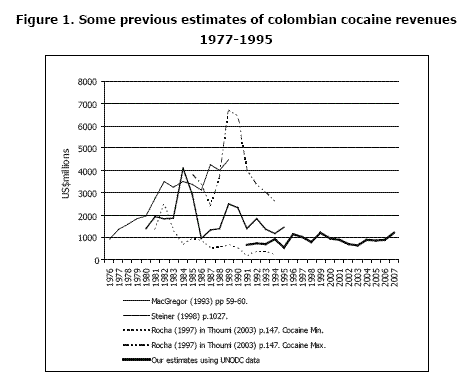
Steiner uses a complex mixture of methods to estimate the value of Colombian cocaine production by imputing from quantities of contraband seized by authorities, estimates of the extent of consumer use internationally, and the Colombian share of the value of wholesale distribution in the United States (1998 p. 1.027).4 His figures are similar to MacGregor's only for the mid-1980s; from 1987 they are substantially lower. After a peak of about 4 billion USD in 1983-1984, the series spikes again in 1989 at 2,5 billion USD, before hovering around 1,5 billion USD annually until the series stops at 1995. In a 1997 study, Rocha provides a much more conservative minimum estimate of cocaine revenues at 2 billion USD in 1981, which steadily diminished to around 200 million USD by the early 1990s.5 Additionally, Rocha provides a maximum estimate that would put the mid-1980s export value on par with that of both MacGregor and Steiner, at around 4 billion USD in 1984, but his maximum estimates of late-1980s values are much higher than both MacGregor's and Steiners's, at over 6 billion USD annually between 1988 and 1990. The maximum range drops below 3 billion USD after 1993. There is thus a great degree of variation in the existing estimates of the value of the cocaine industry to Colombia.
In addition to methodological and technical explanations, another reason for such wide variations in estimates of revenues in Colombia's cocaine industry is the problem of estimating accurately how much of a share of the US wholesale market Colombians manage to appropriate. A substantial share of the US wholesale market would increase dramatically the share of global cocaine revenues appropriated by Colombian citizens - thereby increasing dramatically the size of Colombian cocaine revenues. For example, Steiner cites a 1982 study by Junguito and Caballero which he states "estimated a gross income for all those involved in the trade in a range of $16-28 billion, of which 1% went to the producer, 1,7% to the middleman in Colombia, 17,5% to the wholesaler and 79,7% to the retailer" (Junguito & Caballero, 1982, cited in Steiner ,1998, p. 1.015). And in another source, (although he does not provide a time-series), Vellinga reports that in the 1990s, the total wholesale value of Andean cocaine could have been as much as 8-12 billion USD, with a street value of as much as 74 billion USD (2004, p. 7). He also suggests that as much as half of the export value of Andean cocaine made it back to the producer countries, although the growing participation of Mexican, Brazilian, Venezuelan, US American and European traffickers is substantially reducing the Andean share. Even if the lion's share of total cocaine revenues are generated, laundered and reinvested after further wholesaling, trafficking and retailing beyond Colombia's borders; Vellinga emphasizes that, consistent with Steiner's findings from the early 1990s, "still, income through the drug industry for Colombia alone has been estimated at an average of 2.5 billion US dollars per year in the 1990s" (2004, p. 320). Unfortunately, because of the differing methodologies of older studies and a lack of more recent scholarship, we do not have an up-to-date picture of the value of Colombian cocaine revenues and therefore the significance of the drug industry relative to the rest of the Colombian economy.
Methodology and data
Our estimates of cocaine revenues are based on the potential quantity of cocaine HCl produced in a given year imputed from estimates of the number of hectares dedicated to coca production and the potential yield per hectare of dry coca-leaf in the Andes.6 To determine the value-added and therefore revenues available to producers or traffickers of a particular country of origin at each step in the production process, once we have data on the quantity of coca products, we will also need information on their prices. Our task is made somewhat straightforward thanks to the UNODC's 2007 World Drug Report. According to this source, between 150.000 and 200.000 hectares of land per year are used to cultivate coca bush in Peru, Bolivia and Colombia.7 The UNODC's country-by-country hectare estimates of coca cultivation allow us to estimate coca leaf yield.8 Based on regional and national averages of dry coca leaf yield per hectare from the Bolivian, Colombian and Peruvian country reports, multiplied by the number of hectares in cultivation, the UNODC has estimated a total yearly quantity of dry coca leaf produced in the Andes (broken down by country). From around 100.000 mt of dry coca leaves per year in 1980, throughout the 1980s production increased steadily. Since 1990, between 300.000 and 350.000 mt of dry coca leaves have been produced each year in the Andes region.9 Using scientific estimates of coca yields per hectare, multiplied by hectares of coca cultivated, multiplied by factors representing the quantity of coca paste, cocaine base and finally cocaine HCl that can be refined per unit of coca leaf, the UNODC has provided estimates of quantities of potential cocaine HCL production for each of the Andean countries between 1990 and 2007. Despite government suppression through eradication efforts, due to improvements in crop rotation techniques, fertilizer use, improved refinement techniques and favourable growing conditions that make per hectare yields higher, total Colombian cocaine output has consistently increased since the early 1990s and indeed remains around year 2.000 levels of 600 metric tonnes per year. Figure 2 presents in graphic form the UN data on potential cocaine production, alongside which we have included data on government seizures. The chart demonstrates that while production levels are growing, so is the rate of success of international authorities' suppression of the cocaine trade.
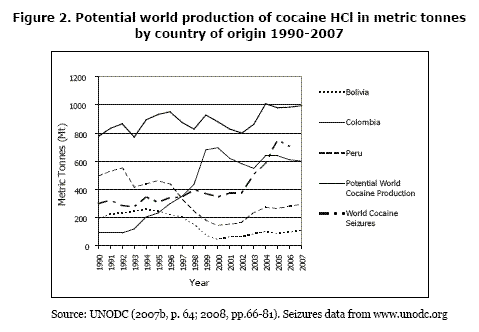
What potential cocaine output per Andean country provides us with is an estimate of the quantity of cocaine HCl that would be produced in each country if all of its coca products were to be refined there. However, we cannot determine exactly the share of cocaine revenues attributable to any given country due to transnationalized production and refinement of coca products. As Thoumi puts it, we cannot know precisely "the share of the Bolivian and Peruvian paste and base that is controlled and internationally marketed by Bolivians, Colombians and Peruvians; and the share of each country's traffickers in the value added generated by smuggling drugs within the Andean countries and outside the region" (2003, p. 143). This problem is akin to trying to determine which share of revenues from one firm's automobile production and sales should be attributed to each country's GDP when the tires are produced in Japan, the electrical components in China, the parts in Canada and the body assembled in Detroit. Likewise, cocaine production involves transnational linkages. According to Grosse, "the basic business of drug trafficking in Colombia involves purchasing and transporting the coca leaf and/or cocaine base from growing regions in Peru and Bolivia, as well as domestically, and manufacturing cocaine hydrochloride in Colombia" (2001, p. 172). To calculate revenues from this business, then, we must have estimates for quantities and prices of coca products (leaf, paste or base) imported into Colombia to subtract from the export value of finished cocaine products leaving the country (i.e. cocaine HCl). This means that "two price series are required: that at which Colombians purchase base from Bolivia and Peru and the one Colombians obtain from their sales in consumer markets" (Steiner, 1998, p. 1.021). We can impute revenues appropriated by producers and traffickers in particular regions if we make our assumptions clear about where particular stages in the production process occur and hence where value is added.
While we have quantity of production estimates from 1987 onwards for Peru, Bolivia and Colombia, we only have complete factor-pricing and value-added estimates for all stages of the cocaine production process for Colombia, and only for the year 2005 (UNODC, 2006, p. 49). Thus we will use these values as proxies in order to construct price series from which we can impute revenues from the Andean drugs business dating back to 1991. As we can see from estimates offered by UNODC in Table 1, if dry coca leaf sells for 1 USD per kilo, at an average annual yield of 6.300 kg/ha, a farmer could generate 6.300 USD per hectare of coca planted. However, once those leaves are transformed into coca paste, the price rises to 879 USD per kg. If 10,2 kg of coca paste are yielded per hectare of planted coca, the annual revenue per hectare planted generated from the sale of coca paste becomes 8.966 USD, for a gain of 44% over the value of dry coca leaf. Combine this gain with the convenience of transporting a much lighter product, there is incentive for primary producers to grow and process coca leaves into paste at the site of production. If the farmer has the resources to process paste into cocaine base, there is a 57% per unit gain in revenue (value-added), which rises to over 107% for those who can produce the finished cocaine HCl.
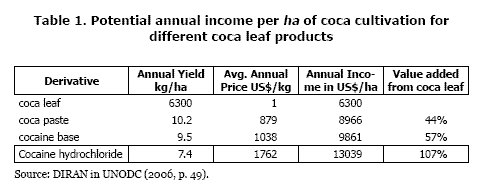
Whether farmer or renegade chemist, based on 2005 data from Colombia, we can state that whoever can turn the coca leaf into pure crystal winds up with a product that is worth twice as much as a field of dry coca leaves (13.039 USD versus 6.300 USD) and weights almost a thousand times less (6.300 kg versus 7,4 kilos), making transportation of the product more cost-effective and more difficult to detect, reducing some of the risk. However, due to the high costs and local scarcity of materials necessary for refinement (such as acid or acetone), it is unlikely that small-scale farmers could afford to refine their dry-leaves beyond the paste-stage. Since they have access to the expertise and resources, large drug-cartels can make use of economies of scale to perform more cost-effectively the transformation of coca paste to cocaine base to cocaine HCl. Thus we will suppose that all of the world's finished cocaine HCl is produced in Colombia, but it is produced using a combination of Colombian, Peruvian and Bolivian paste (and not cocaine base).10 We also know that Colombia rather than Peru or Bolivia has been the primary centre of cocaine HCL manufacture since the 1970s even if paste and base are imported from these other Andean countries,11 so historical evidence and economic rationale support our assumption.
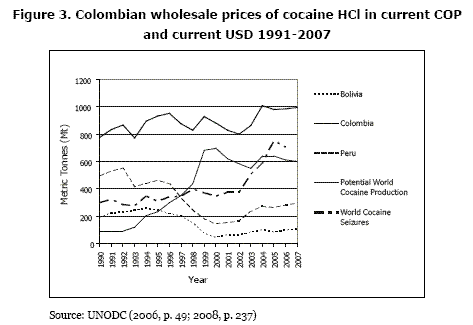
In any case, the available data makes our methodological choices for us: we do have a time series of Colombian wholesale prices in USD and COP for cocaine HCL for 1991-2007 (see Figure 3); and we do have wholesale prices for Bolivian and Peruvian coca leaf for (1991-2007). From this latter series we can estimate the value of coca paste imports from those countries using the average of 44% mark-up per unit price from the Colombian data (UNODC, 2006, p. 49). Thus we calculated the value of coca paste imports into Colombia by multiplying by a factor of 1,44 the unit cost of dry coca leaves at Peruvian and Bolivian market prices.12 This of course assumes, once again, that it is far more likely that paste is imported to Colombia from the other Andean producers and not dry leaves considering their price to volume ratio as noted above. Finally, we calculated the value of Colombian cocaine revenues by multiplying the total potential Andean cocaine yield in tonnes by 1.000, multiplied by the current Colombian wholesale market price per kilo of cocaine HCL. This gave us an estimated total value of Andean cocaine production from 1991-2007 in USD. We then subtracted the value of Peruvian and Bolivian coca paste imports (price times quantity of coca leaf times 1,44). In addition to subtracting the price of Peruvian and Bolivian imports from Colombia's gross cocaine revenues, we also subtracted the value of government seizures of cocaine HCL.13
- Thus:
Colombian Cocaine HCL revenues
Equals: Total Andean Cocaine Production (quantity in kg * Colombian wholesale
price)
Minus: Peruvian coca paste imports (coca leaf price per kg * quantity * 1.44)
Minus: Bolivian coca paste imports (coca leaf price per kg* quantity * 1.44)
Minus: Colombian Government Seizures (quantity*Colombian wholesale price).
The resulting data-series is of the total value of annual revenues in Colombia's cocaine
industry at Colombian wholesale prices industry from 1991-2007.
Results
Cocaine revenues that can be attributed to Colombian producers and traffickers fluctuate between 600 million USD to 1,2 billion USD, depending on annual yields, confiscations, factor prices (including the cost of imported Andean coca products), and the success of eradication programs. In fact, revenues fluctuate so drastically from year to year that the industry can only be characterized as extremely volatile and risky as a business sector, even if one puts aside the additional risks posed by competitors with a penchant to use violence and state authorities looking to suppress the entire industry. We display our findings in Figure 4.
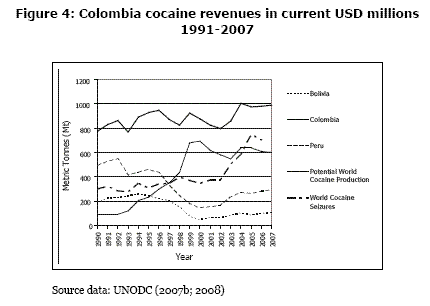
In terms of the validity of our findings, we can see from Figure 1 that our findings fall within the general range of estimates on Colombian cocaine revenues. The early part of our series is consistent with Steiner's findings and falls midway between Rocha's minimum and maximum thresholds. However, since we calculated the revenues likely attributable to Colombian producers at Colombian wholesale prices (not at US wholesale prices), our estimates of revenues from the cocaine industry can be considered low compared to some previous findings from the early 1990s.
However, if we were to take into account the share of profits accrued to Colombians involved in trafficking cocaine beyond Colombian territory, Colombians' cocaine revenues would increase since the action of transporting cocaine across international boundaries alone increases dramatically the value-added of cocaine HCl.14 We will not speculate on exactly how much Colombians appropriate of the global trafficking revenues or the global wholesale market. But we can get an idea of the revenues up for grabs from cocaine trafficking beyond the Andean producer countries. We calculated global cocaine revenues broken down into shares accrued to producers, traffickers and retailers based on Colombian and US American wholesale prices, and US retail prices, subtracting of course the quantity of global seizures from data obtained from UNODC. Since we already have the share of production revenues in the Andean data, we calculated traffickers' revenues using US wholesale prices per kilo from 1991 to 2005 using data from the UNODC World Drug Report, 2007 & 2008. Further, we calculated the additional value added of street level retail sales in USD per gram in order to estimate the global revenues of retailers (street-level dealers). These estimates might be low-balled as the growing Eastern European market dictates that cocaine sells for more in Europe than in the United States, however we use the US retail prices as we have no way of dividing up the share of the global Cocaine product accurately by country or region. We present our findings in Figure 5.
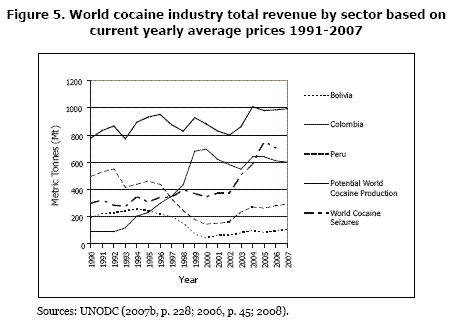
We can see from Figure 5 that the global revenues from the cocaine industry have been in decline for traffickers and retailers. With governments seizing an increasing share of the product at border stings or in raids, overall profits are diminishing and the industry would appear to be getting more dangerous for participants risking jail-time or violent death at the hands of competing firms. Further, as other drugs such as ecstasy, Crystal Meth, heroine, and marijuana become cheaper and more readily available, the American street value of cocaine HCl is in decline. While the gross retail value of cocaine still suggests massive global revenues, in the range of 20 to 40 billion USD annually, profits are widely distributed among a great number of street-level retailers and regional traffickers. And as we are going to see, since the control over cocaine production and export in Colombia is concentrated, far fewer players share in the revenue pie, making the potential for huge profits extremely high. And, if our findings are accurate, despite yearly fluctuations, the production value of Colombian cocaine has remained fairly constant (on average) since the early 1990s.
Discussion: the cocaine industry & the colombian economy
Our goal from the outset of this paper has been to provide some empirical grounding upon which to construct a theoretical framework that places the underground economy within the overall context of Colombian political economy. Because the cocaine industry is part of the underground economy, revenues from production are not directly accounted for in calculations of the country's gross domestic product. Nevertheless, since a portion of revenues are laundered, banked and either directly invested in other sectors such as construction or real-estate, or reinvested in the stock market, joining global financial circuits, cocaine revenues eventually show up in the national accounts, listed as other sources of revenue. Pin-pointing exactly where cocaine money turns up in the formal economy is perhaps impossible, and certainly we will not attempt it here. But we can use our findings from the previous sections to provide a sketch of the relative size, productivity, profitability, and level of concentration and power in the cocaine industry compared to the rest of the Colombian economy.
By our calculations, cocaine revenues were worth between 600 million USD and 1,2 billion USD to Colombia alone each year from the early 1990s to 2007. In relative terms, how does this value compare to other sources of revenue for the Colombian economy? In Figure 6 we plotted our estimate of cocaine revenues as a percentage of GDP using current US dollar figures obtained from the World Bank. Cocaine revenues hovered around 1 % of GDP throughout the 1990s with a high of 1,61% of GDP in 1991, dropping to a low of 0,56 % of GDP in 1995 and peaking again at 1,38% of GDP in 1999. Since 1999, there has been a gradual decline in the relative importance of the cocaine industry to the over-all economy as over-all growth intensified while cocaine revenues remained on the average stable (if volatile).
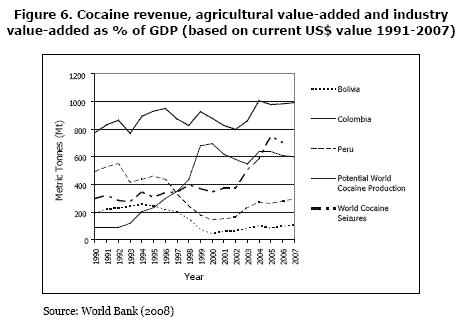
We also plotted Industry value-added as a percentage of GDP in Figure 6. Industry (including manufacturing and extractive industries) as a percentage of GDP dropped from around 37% in 1991 to a low of 28% in 1998-1999, gradually rising again to about 35% of GDP by 2006 (before dropping off again in 2007). Further, value-added from agriculture, also plotted in Figure 6, declined from around 15% of GDP in the 1990s to 11% by 2007. While in absolute terms, the cocaine industry amounts to only a small portion of Colombian productivity, considering it is concerned with the production of just one type of commodity (and an illegal one at that), it is significant. Further, despite large yearly fluctuations, the value of cocaine production as a share of GDP has remained fairly constant on average since the early 1990s while agriculture is in decline and industrial output prone to long cycles. While this is likely due to an overall intensification of economic growth due to a rise in productivity in the service sectors and in resource extraction more than an absolute decline in agricultural productivity, it does point to the consistency and resilience of the cocaine industry. Despite being illegal, facing the efforts of the international security system to suppress it, and taking place within the terrain of battle between armed factions, the cocaine industry continues to persevere and produce significant revenues.
In Figure 7 we present the value of revenue in the cocaine industry as a percentage of revenue in both agriculture and industry. Cocaine production equals on average around 8% of agricultural value added (with a high of 10% in 1999 and a low of 4% in 1995). Cocaine production would be worth around 3% of value-added from industry to the Colombian economy in the average year between 1991 and 2007, with a low of 2% in 1995 and a high of 5% in 1999. Nevertheless, eyeball analysis of the long-term trends suggests that cocaine production is becoming less important as the formal economy grows considering that cocaine production has been less than 1% of GDP every year since 2002. But in absolute terms, the fact that just one product, cocaine HCl, could account for the equivalent of 8% of agricultural output and 3% of industrial output suggests the enormous size and profitability of this sector of the shadow economy.
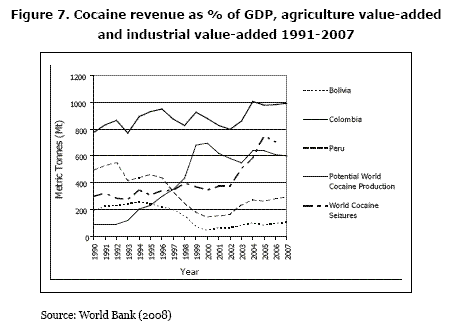
Further, in considering the productivity of the cocaine industry, it is important to sketch out employment patterns and wealth distribution within this sector of the shadow economy. Estimates of the numbers of people employed in the cocaine industry vary widely, on the one hand due to the insecure nature of working conditions in this illegal industry which employs many migrant and seasonal workers in precarious and often dangerous conditions, but also due to difficulties in accurately measuring illegal activity. According to estimates made by the Colombian government and UNODC, there are perhaps 68.000 households that rely primarily on coca cultivation as a source of income (2006, p. 6).15 Grosse characterizes the class structure and division of labour within the cocaine industry as a pyramid at the top of which rest 10 core organizations (Grosse, 2001, p. 174). These are what we typically call cartels, really crime syndicates that pool their resources in order to improve the efficiency of production, distribution and protection.16Grosse estimates that in all, these core firms would employ around 500 people. Below these firms in the hierarchy are a number of smaller but more numerous (around 100 or so) specialized firms providing transportation services, money laundering, protection and enforcement of contracts, and laboratory operations. Below these would be perhaps another 1.000 freelance workers with varying skills including pilots, chemists, financial advisors, brokers, assassins, lawyers, accountants and paramilitary commanders. Below that would be another 1.000 part-time workers performing various tasks such as security, running messages and packages, doing surveillance, operating radio and telecommunications equipment, operating machinery, performing manual labour, and working as smurfs (those who break down large amounts of cash into smaller bundles that can be deposited in bank accounts). Finally, there are the 100.000 to 135.000 coca growers, agricultural workers and primary producers at the base of Grosse's pyramid (2001, p. 174).
In a country of 44 million people, then, between 0,2 and 0,3% of the population produces the equivalent of 1 to 1,5% of the country's total production, all of it unaccounted for by the institutions that control the formal economy, leaving it untaxed, un-regulated and often expropriated by both legal and extra-legal force. Now, consider that in 2005, 22% of Colombian workers were employed in agriculture, producing only 12,5% of GDP according to World Bank's Development Indicators. Further, within the industry wealth and power are highly concentrated. Consider that a handful of strong-men sit atop a rigid hierarchy of perhaps 500 to 2.500 employees, who, after having bought the factors of production and paid the primary producers of coca paste and cocaine base can then manufacture and export a product that generates them revenues worth at least twice what they paid for the inputs. If the 100.000 or so primary producers took in half of Colombian cocaine revenue (based on estimates of value added in the production process presented above), then that leaves still between 0,5 and 1% of their country's GDP to the traffickers. Even if there were 10 big cartels employing 2.500 people, that would mean that 25.000 people, or 0,05% of Colombia's population would earn the equivalent of 0,5 to 1% of its GDP in just one sector of the shadow economy. This figure would likely be much larger considering the potential for a larger Colombian share in the overseas wholesale cocaine market than we are assuming here, not to mention further revenues from investments of laundered money in other sectors such as construction, real-estate, retail goods imports, and entertainment.
In terms of productivity (revenue generated per worker), then, the cocaine industry is highly profitable but also highly risky for producer and trafficker. Nevertheless, despite the risks, because of the exclusion of many rural workers from opportunities within the formal economy on the one hand, and the exploitation of cheap labour within the formal economy on the other, many peasants continue to be driven into coca production, and urban youth continue to seek employment with drug-cartels.
What does it mean for the Colombian economy that there would be a highly profitable illegal industry overwhich control is highly concentrated in the hands of a small segment of the population. How does the quantity of wealth controlled by drug-firms compare to other large sums of money in the economy. How does this effect the economy at large? The answers to this question are suggested by another comparison. The cocaine industry is so big that in the early 1990s it represented more than half of the value of net direct foreign investment in the country. As we can see in Figure 8, while foreign investment rose substantially during the first years of Plan Colombia, and more recently as the government has continued to welcome investment by multinational corporations, if FDI is any benchmark, the cocaine industry still remains an important potential source of finance for economic development.17
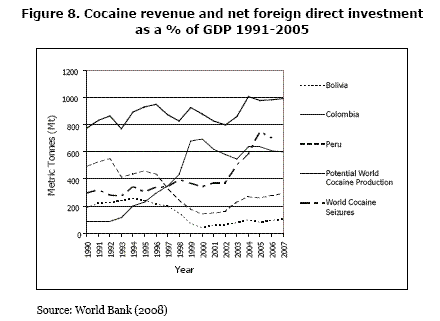
So big perhaps is the cocaine industry, that it might actually boost over-all economic growth. Indeed, this is the point made by Camila Pardo in a 2005 article suggesting a positive relationship between growth in narcotics production and economic growth in the Colombian economy.18 Not only does it appear that increased illicit drug production correlates with economic growth, but solely in terms of economic growth figures, the economy also benefits from foreign aid aimed at addressing the problem (even despite the negative effects of political instability) (2005, p. 464). The implications are rather astounding: indeed, while illicit drug trafficking is seen by most governments as a source of instability in the international system, the inconvenient reality is that a small but powerful elite manages to benefit from narco-capital accumulation both directly, as it provides a direct source of liquid investment to finance the business activities of domestic and multinational corporations in control of Colombian capital accumulation; and indirectly, as the continuation and persistence of narco-production and trafficking strengthens the resolve of international policy-makers (particularly those in the United States) and ensures that they provide a steady flow of international military aid into the coffers of the Colombian armed forces.
Power and capital accumulation in the cocaine industry
We will finish off this paper by using our findings to speculate on the relative power of Colombian cocaine firms within the context of Colombian capitalism. Political economists Jonathan Nitzan and Shimshon Bichler have developed a measurable concept of political power within modern capitalist economies based largely on Israeli and US American data. The most powerful firms operating within the core sectors of the economy are those that consistently post profits better than the average of their competitors. The executives of dominant firms are able to exercise power in their societies not simply because of their net worth in absolute terms, but rather in their relative share of the economic pie within their sector and within their society. Nitzan and Bichler's concept of differential accumulation measures the growth rate of a particular firm within an industry, or a particular industry within the wider economy as a whole, in relation to the average growth rate of a firm or of the economy as a whole (2002, pp. 171-174). If a firm can grow outwards (by expanding into green-field sectors of the economy) or intensify production inwards (by increasing productivity per employee) at a faster rate relative to its competitors, it can be said to be more powerful and influential in the economy as a whole, enabling its executives to enhance their share of social power in society at large.
We have already seen that the cocaine industry is productive in terms of output per worker, and is likely to be highly profitable for firms that survivie, creating the potential to accumulate huge sums of money that can be invested as financial capital within the banking system. If we consider, as Nitzan and Bichler put it, that "modern capital is finance and only finance" (2002, p. 36) any firm able to bank and then invest large sums of financial capital can count themselves among the core of the dominant capitalist class.
Thus, once drug firms manage to launder their money and convert it into bank holdings, they would be perfectly capable of controlling "legitimate" investments within the wider economy worth a substantial portion of the country's bank holdings, or they would be capable of controlling investment funds as large as those of many institutional holdings or pension funds. The laundering and banking, that is, the financialization of accumulated drug profits then, would give drug barons great potential to take "a share of control over the social process," as Nitzan and Bichler put it (2002, p. 36). In other words, it would make them very powerful players in Colombian society. Financialization occurs either through the Colombian banking system or through foreign banks. Once legally banked, illegally accumulated financial capital could be invested anywhere in the world. Drug lords, insofar as they can launder and bank their money, are really narco-capitalists. As Thoumi remarks, "Drug traffickers are good capitalists, and illicit drug capital flows behave in a way similar to any other international capital flow: they are influenced by macroeconomic conditions in the Andean countries, the United States, and other countries, as well as by fiscal and monetary policies" (2003, pp.145-146). While we cannot measure directly the power in terms of capital holdings and differential accumulation of any particular drug cartel in Colombia, as we have no way of opening up the books and obtaining exact annual revenues per firm, nor estimating the total capital holdings of illegal firms, we can still apply Bichler and Nitzan's reasoning to roughly measure the potential power of Colombia's cocaine elite relative to the most powerful legal firms in Colombia's economy. This will involve a thumbnail sketch of the revenues of cocaine firms relative to the market value of large legal firms.
Let us say, following Grosse (2001, p. 174), that 10 core firms sit atop the cocaine industry which brought in revenues of 856 million USD in 2005. Even after paying half of these revenues to primary producers for production costs, that leaves over 400 million USD in annual net revenue to be divided among them (assuming that there are no further costs and having already subtracted government confiscations). Financial Times of London data reports that in 2005, Ecopetrol's net income was 3'253.756 millions COP, or 1,4 billion USD at 2005 exchange rates (2009, Feb. 10). Bancolombia's 2005 net income was 409 million USD (2009, Feb. 10). While Bavaria S.A beverage group had total revenues of over 2,2 billion USD, after taking into account operating expenses and taxes, net income was only 34,6 million USD (2009, Feb. 10). These firms are the only Colombian firms to make it onto the Financial Times Top 100 firms in Latin America in 2005. Considering that one of the core cocaine firms could potentially take in 40 million USD net income in a given year, cocaine firms would rank high among Colombia's most profitable corporations. And if a dedicated and prudent narco-capitalist could manage to clean and bank a good share of his fortune, he could translate illegally accumulated narco-wealth into a substantial sum of capital. Thus narco-capitalists, should they succeed in cleaning up their illegally accumulated fortunes, could potentially be among the most powerful members of Colombian society, if indeed, as Nitzan and Bichler put it, capital is finance and finance easily translates into social power.
But what about the dynamics of narco-capital accumulation in relation to the wider Colombian economy; how does narco-capitalist accumulation perform relative to the rest of the Colombian economy over time? As noted above, Nitzan and Bichler's concept of differential accumulation could be used to measure the performance of a particular industry compared to some measure of the economy as a whole (2002, pp. 171-174). And so, we compared the growth-rate of the Cocaine industry expressed as an annual percentage change in total revenues with Colombian GDP annual percentage growth. While generally the cocaine industry has the potential to grow dramatically year by year, it also can shrink drastically, due to government seizures, crop failure, sabotage on the part of competitors, input shortages, labour shortages, etc. As we can see from Figure 9, in the 1990s, growth rates were dramatically higher in the cocaine industry than in the economy as a whole, except for the years 1993, 1995, 1997 and 1998, when huge declines in output put growth in the cocaine industry well below that of the formal economy. After 1999, growth in the cocaine industry fell far below growth in the formal economy in all but two years, 2004 and 2007. Once again, while cocaine can still be wildly profitable and empower a small group of people, as a productive sector it is prone to volatility and exposes narco-capitalists and workers to extremely high levels of risk.
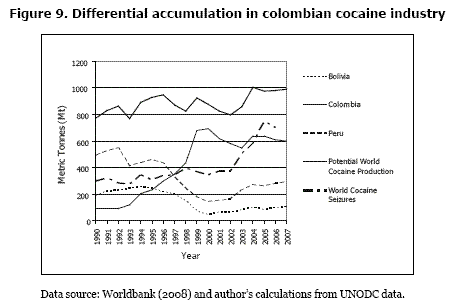
Even if narco-capitalists do not succeed in turning illegally accumulated drug profits into licit financial holdings, their power over the future of Colombian society can be exerted in other ways. As the political adventures of Pablo Escobar and his contemporaries,19 as well as recent allegations of drug-money being used to fund political campaigns attest, drug revenue that does not get laundered and legitimized as financial capital still allows drug-lords to exert extraordinary influence over the formal political system and governmental institutions through cash payments of bribes to corrupt politicians, police, military officials and judges. Further, illegally accumulated drug revenue that it is not legitimized and reinvested in the formal sector can still be reinvested back in the cocaine industry itself, or in some other sector of the underground economy which operates on the basis of cash payments. Thus Drug-cash is used to open up further coca production and cocaine manufacturing which spins-off into investment in materials, workers, and armed protection. Drug money has provided the means through which various business interests can foot armies, either to protect the interests of landed capital as in the case of paramilitary armies, or to fund private mercenary armies for hire to domestic and foreign capitalist firms (Melo, 1998, pp.79-81). This creates insecurity, social instability and drives mass displacement out of the countryside into urban centres. According to Melo, drugs money has also been cited by many politicians and observers as the means through which the FARC and ELN continue to stage their existing political struggles through violent means, thus suggesting that drugs-money fuels armed conflict in the country on either sides of the political spectrum.20
Conclusion
We can conclude that while the cocaine industry is a risky business, it is also highly productive in terms of output per worker if agricultural output and industrial value-added serve as benchmarks. Nevertheless, the relative importance of the cocaine industry to the Colombian economy as a whole appears to be in decline, as GDP growth suggests productivity increases in manufacturing and industry (particularly the extractive resource sectors) and foreign investment is on the rise. However, this could change if the cocaine industry has a few more highly productive years, and given the volatility of the sector, this is possible. This illegal sector of the economy has the potential to be highly profitable for those willing to take the risk and success in this sector can endow narco-capitalists with extraordinary (and extra-legal) powers. As Steiner puts it: "Even if the true economic dimension of drugs in Colombia is smaller than what is generally suggested both in the press and in political circles within the United States, it is still the case that the drug trade provides resources to a very small group of outlaws, with enormous power to corrupt the country's social and political fabric" (1998, p. 1.013). In this paper we have tried to put a dollar value on the capacity of powerful illegal capitalists to finance Colombian financial capital accumulation and corrupt the institutions of the state.
Now that we have the empirical foundations for a framework in which to theorize the place of the cocaine industry within the wider context of Colombian capitalism, a number of lines of investigation open up. What remains to be done through further empirical work is to investigate in more detail the ways in which the highly profitable but highly dangerous cocaine industry interacts with Colombia's formal economy. For example, to what extent does expansion of illicit drug production use arable land that could otherwise be used for the production of legal crops?21 The relationship between agricultural land-tenure, colonization, expansion of the agricultural zone, forced rural displacement, agro-capitalist development and the coca industry requires sustained scholarly attention. Who are the primary producers of coca crops? Are they predominantly displaced rural peasants colonizing new land, or are they small tenured land-holding peasants, or migrant workers contracted by narco-capitalist firms seasonally to pick leaves? To what extent is land seized by illegal armed groups turned over to coca cultivation? How does illegal drug production feed into the process of accumulation of land and property for the larger process of expansion of agro-capitalist production?
From further empirical work on questions such as these we can begin to accurately theorize how the illicit economy creates opportunities for those marginalized by Colombian capitalism, how it allows criminals to compete with institutionalized power brokers, and how cooperation between illicit capital and some elements within the Colombian state corrupts both state and society at large. This will involve further quantitative work on differential accumulation within the Colombian economy to better tease out the net economic impacts of the cocaine industry on Colombian capitalism; however, it will also involve an historical sociological investigation into the social forces (including a predatory global capitalism) that drive Colombians into the cocaine industry in the first place.
Notas
*Article of scientific investigation.
1 For a detailed treatment of this theme see Grosse (2001).
2 An historical account of the links between cocaine traffickers and groups involved in armed conflict in the 1980s and early 1990s is to be found in Melo (1998).
3 A rich and dynamic historical account of the paramilitarization of the Colombian state is laid out in a forthcoming book by Hristov (2009).
4 Steiner questions the validity of some academic accounts of the size of the cocaine industry which are based uniquely on estimates by journalists or whose authors were less than explicit about their methods. Steiner's highly detailed and extensively researched account of some older studies of cocaine revenue in Colombia, most notably a 1990 study by esteemed Colombian political economist Salomon Kalmanovitz, is a must-read, so we avoid a more detailed summary here.
5 Rocha's 1997 data series is published in Thoumi (2003, p. 147). The original source is Rocha, R. (1997). Aspectos económicos de las drogas ilegales en Colombia. In Thoumi, F. (Ed.), Drogas ilícitas en Colombia: su impacto económico, político y social. Bogotá: Dirección Nacional de Estupefacientes and United Nations Development Program, Editorial Planeta.
6 Of all the clandestine cocaine labs discovered and destroyed by government authorities worldwide, 99% of those were in Colombia, Bolivia or Peru as reported by UNODC (2007 p. 12). This suggests that virtually all of the world's cocaine HCL is indeed produced in the Andes where raw coca plants are harvested. UNODC reports that only a few tons of dry coca is produced each year in Ecuador. The practice was apparently abandoned by Indigenous tribes in the 1950s according to Leon (1952).
7 UNODC (2007b) provides estimates of global cultivation of coca bush in hectares of land use (1990-2006) based on satellite images and local reports. While the total land use in the three countries for coca cultivation in hectares remained fairly constant between 1990 and 2002, (around 215-225 000 ha per year) there was a significant drop in production in Peru and Bolivia from 1998 to 2002. This is likely due to government repression of indigenous coca cultivators in Bolivia, a relative decline in the power of the Sendero Luminoso in Peru, as well as a blight that affected coca plants in that country (Vellinga, 2004, p. 5). Furthermore, the interdiction of air traffic in Andean air space imposed by the US Airforce interfered with small plane transports of coca products, see Friesendorf (2005, p. 46). At the same time, the level of global coca production was maintained by increased coca cultivation in Colombia after 1998. When production dropped in the coca supply zones in the late 1990s, Colombian cocaine manufacturers sourced domestic sources of raw coca leaf and base.
However, an overall decline in world coca cultivation occurred between 2001 and 2003, likely attributable to efforts to eradicate coca fields by the Uribe government as part of Plan Colombia. While the aerial bombardment of the countryside with thousands of tonnes of herbicide, along with forced manual eradication of coca crops by political prisoners, supported by US military aid, may be making a dent in global coca cultivation, the nefarious side effects include the eradication of subsistence food crops, livestock, and water supplies upon which rural peasants and indigenous Colombians rely. Despite such controversial actions, since 2003, global and Colombian coca cultivation has remained constant with around 150 000 hectares of land planted with coca (often lying beyond the agricultural frontier, but also to be found in interstitial spaces between fields of legitimate crops well within the agricultural heartland of Colombia). The geographic and politicaleconomic dimensions of Andean coca cultivation are to be the subject of forthcoming work by the author, particularly the repercussions to Colombia's banking system following the shift of coca production toward Colombia from Peru and Bolivia in the late 1990s.
8 Variations in estimates at this stage are due to in Thoumi's view to "the type of coca plants and their age; weather conditions; coca plant density per hectare; the amount and types of fertilizers and herbicides used; the frequency of pruning; the skills of chemists and the type and quality of the chemicals used; and the time between the moment leaves are harvested and the actual refining process begins" (2003, p. 142). There is then, a great room for error in any estimate of coca yield extrapolated from hectare estimates of coca cultivation.
9 For data see UNODC (2000a, p. 40; 2000b, p. 24)
10 Which is consistent with Steiner (1998, p. 1.026)
11 Colombian traffickers were already established as marijuana exporters before commercializing for mass consumption the traditional Andean coca leaf, by importing coca products from traditional growing areas elsewhere for manufacture in Colombia. See Melo (1998).
12 Because we are forced to use Colombian value-added estimates for the transformation from coca leaf to coca paste on Peruvian and Bolivian quantity estimates, we encounter a methodological problem. This ratio may not apply to Bolivian and Peruvian paste due to regional differences in leaf opiate concentrations and differences in refinement techniques and materials. Further, using the 2005 data on leaf to paste value added is problematic due to the likelihood of yearly variations in production yields and local factor prices. As such, our estimates of Bolivian and Peruvian coca products imported to Colombia can only be a proxy.
13 Quantities of Drugs seized were obtained from the UNODC's website at http://www.unodc.org/ unodc/en/organized-crime/bi-annual-seizure-reports.html.
14 As Thoumi (2003, p. 149) and Steiner (1998, p. 1.021), both point out, it is difficult to estimate how much of profits generated through wholesale and retail cocaine sales in consumer countries are appropriated by Colombians as opposed to foreign traffickers and dealers since it is unclear when and where in the distribution chain sales take place and at what wholesale prices, those of Colombia or those of the receiving country.
15 Estimating that producers who grew coca likely made paste out of leaves before selling them, the UNODC puts household coca growing income at around 843 million USD in 2005 and 683 million USD in 2006. If these figures are accurate, the report goes on to estimate that the coca household share of cocaine revenues would be at around 12 300 USD and 10 100 USD respectively for 2005 and 2006 (2006), putting the coca growing peasant substantially better off in purely economic terms than the average Colombian who could expect just over 2000 USD GDP per capita in 2005. This estimate puts the share of production given to primary producers close to our total estimate of Colombian cocaine revenue and suggests that the authors ignored concentration of control over trafficking and the use of power and coercion in the distribution of revenues. Simply calculating the value of the crop and dividing it by the estimated number of total producers does not necessarily give an accurate picture of average cocaine revenue earned by the producer; the UN estimate does not take into account class hierarchies based on the division of labour between producer and trafficker, nor the insecurity of person and property due to a concentration of power and control over the productive process by an armed and violent few. Thus, beyond bare-faced economic estimates of well-being based on income, the UN estimate ignores the reality of the coca producing peasant who, while waiting to sell the product of their labour to heavily armed and dangerous narco-trafficers, is at risk of expropriation and attack by government forces, of exploitation at the hands of armed paramilitaries and open to extortion from rent-seeking guerrillas.
16 For a discussion of the way cartels operate, see Thoumi (2002, p. 108).
17 According to UNODC Secretary-General Antonio María Costa, speaking with Austrian news magazine Profil during the current financial crisis illicit drug money has become one of the only available sources of liquid investment capital, and that there is evidence that interbank loans have been financed with capital derived from drug trafficking and other illegal activities, even to the point where Costa surmises that some banks have been saved from bankruptcy in this manner way. In Profil (2009) (Thanks to Julian Germann for pointing out and translating this reference).
18 Pardo does not provide specific dollar estimates for illicit drug production revenues. Instead she measures narcotics production based on hectares of land used to cultivate illicit crops (coca and marijuana) and finds a positive relationship between this variable and GDP growth from 1994-2002. In particular, see 2005 (pp. 460-461, 417-476).
19 On drug cartels involvement in institutionalized politics in Colombia in the 1980s and 1990s see Melo (1998, pp. 68-77)
20 However, according to Melo, the relationship between coca production and guerrilla insurgency is complex and requires further investigation (1998, pp. 80-82)
21 While coca production used to occur beyond the agricultural frontier, or at the margins of the agricultural frontier, with only about 2% of arable land used for coca cultivation, in recent years, more and more arable land within the agricultural regions of the country is being used for coca cultivation, somewhere in the region of 6% in 2002, according to UNODC estimates (2006, p. 64)
Referencias bibliográficas
1. Arango, C., Misas, M., & Lopez, E. (2006). Economía subterránea en Colombia 1976- 2003: una medición a partir de la demanda de efectivo. Revista Ensayos sobre Política Economica, 50, 155-211. [ Links ]
2. Financial Times (2009, Feb. 10). MarketsData. Retrieved from http://markets.ft.com. [ Links ]
3. Friesendorf, C. (2005). Squeezing the balloon? United States air interdiction and the restructuring of the south american drug industry in the 1990s. Crime, Law and Social Change, 44, 35-78. [ Links ]
4. Grosse, R. (2001). Drugs and money: laundering Latin America's cocaine dollars. Westport, Conn.: Praeger. [ Links ]
5. Hristov, J. ( 2009). Blood and capital: the paramilitarization of Colombia. Athens, Ohio: Ohio University Press. [ Links ]
6. Kalmanovitz, S. (1990). La economía del narcotráfico en Colombia. Economía Colombiana, 226-227, 18-28. [ Links ]
7. Leon, L.A. (1952). The disappearance of cocaism in Ecuador. América-Indígena, Quarterly Review of the Inter American Institute of Indigenous Studies, 12(1). [ Links ]
8. MacGregor, F. (1993). Coca and cocaine: an andean perspective. (J. Cavanagh & R. Underhay, Trans.).Westport, Conn.: Greenwood Press. [ Links ]
9. Melo, J.O. (1998). The drug trade, politics and the economy: The colombian experience. In E. Joyce & C. Malamud (Eds). Latin America and the multinational drug trade (pp.63-96). New York: St. Martin's Press. [ Links ]
10. Nitzan, J., & Bichler, S. (2002). The global political economy of Israel. London: Pluto Press. [ Links ]
11. Pardo, C. (2005). El problema mundial de las drogas ilícitas: su efecto positivo en el crecimiento colombiano. Papel Político, 18, 417-476. [ Links ]
12. Profil. (2009, Feb. 10). Wurden banken mit drogengeld gerettet? Das einzige verfügbare Investmentkapital. Retrieved from http://www.profil.at/articles/0904/560/231759/ wurden-banken-drogengeld-das-investmentkapital. [ Links ]
13. Steiner, R. (1998). Colombia's income from the drug trade. World Development, 26(6), 1.013-1.031. [ Links ]
14. The Economist. (2004, october 23). The Americas: lording it over Colombia; Colombia's paramilitaries and drug lords. The Economist, 373(8.398), 53. [ Links ]
15. Thoumi, F. (2002). Illegal drugs in Colombia: from illegal economic boom to social crisis. Annals of the American Academy of Political and Social Science, 582, 102-116. [ Links ]
16. Thoumi, F. (2003). Illegal drugs, economy and society in the Andes. Washington D.C.: Woodrow Wilson Centre Press. [ Links ]
17. Vellinga, M. (2004). The political economy of the drug industry: Latin America and the international system. Gainesville: University Press of Florida. [ Links ]
18. UNODC -United Nations Office on Drugs and Crime- (2000a). Global illicit drugs trends, ODCCP studies on drugs and crime. Retrieved on July 5, 2007, from http://www.unodc.org/pdf/report_2000-09-21_1.pdf. [ Links ]
19. UNODC -United Nations Office on Drugs and Crime- (2000b). World drug report 2000. Retrieved on July 5, 2007, from http://www.unodc.org/unodc/en/ world_drug_report_index.html. [ Links ]
20. UNODC -United Nations Office on Drugs and Crime-, Government of Colombia (2006). Colombia coca cultivation survey. Retrieved on July, 4, 2007, from http://www. unodc.org/unodc/en/crop_monitoring.html. [ Links ]
21. UNODC -United Nations Office on Drugs and Crime- (2007a). Coca cultivation in the Andean Region. A Survey of Bolivia, Colombia, Ecuador and Peru. Retrieved on July 5, 2007, from http://www.unodc.org/unodc/en/crop_monitoring.html. [ Links ]
22. UNODC -United Nations Office on Drugs and Crime- (2007b). World drug report 2007. Vienna: Author. [ Links ]
23. UNODC -United Nations Office on Drugs and Crime- (2008). World drug report 2008. Vienna: Author. [ Links ]
24. World Bank (2008). Data and research, Millenium development goals, World development indicators, 2007 and 2008 data. Retrieved on Feb.10, 2009, from www.worldbank.org. [ Links ]














